St
Mary-at-the-Quay

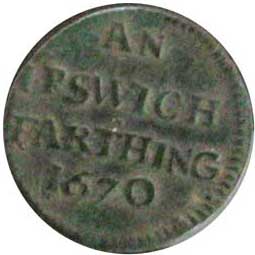
The
weather-vane and the wrought iron gateway
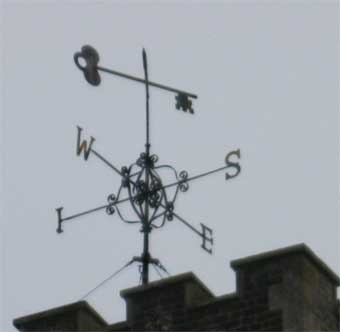 2014 image
2014 image
Approaching the church of St Mary-at-the-Quay – the middle of
the
three medieval dockland churches – from St
Clement, the weather vane is
still in place, the key
forming the vane at the top. The gold-painted key vane
was in place by the 1670s, but what we see today is a more recent
replacement, albeit with a broken 'N'. The word 'key' is said to be a
version of
the word 'quay', as the church is a matter of yards from the Wet Dock. In
1306 the quay was known as the 'Kay', from its Danish equivalent 'Kaai'
and the Middle English 'Caie'.
 2013 images
2013 images
Although there is little noticeable lettering on the fabric of
the
building, the wrought iron gates include a monogram with the key symbol
linking the 'S' and 'M'. In 2013 this is picked out in red paint.
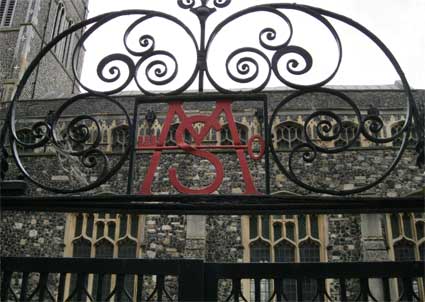
See our Albert Clarke, 'Art Smith'
page for his own photograph of the gates after he had made them.
See our page on Public
clocks in Ipswich for a 2018 view of the church tower and its
clock(s).
The south door is the main entrance to the church and we
understand that in 1876 the door from the old Grammar School was placed
here; presumably it is the one we see today. The plaque above the south
door is almost unreadable, so we include the text here, with its odd
lack of
full stops:
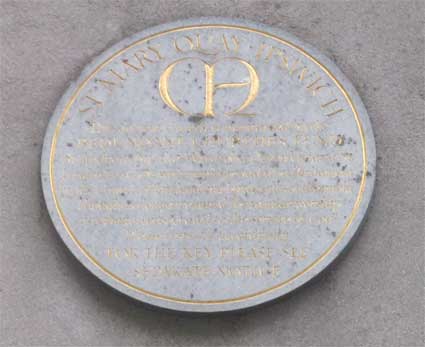
'ST MARY . QUAY .
IPSWICH
This ancient church is maintained by the
REDUNDANT CHURCHES FUND
St. Andrew-by-the-Wardrobe, Queen Victoria St.
London EC1V 5DE with monies provided by Parliament
by the Church of England and by the gifts of the public
Though no longer required for regular worship
it remains consecrated to the service of God
Please respect it accordingly
FOR THE KEY PLEASE SEE
SEPARATE NOTICE'
Built on the site of an earlier place of worship the main period
of construction of St Mary-at-the-Quay was 1443-1543, supported by rich
merchants who lived in the area, notably Henry
Tooley, whose tomb can be found in the north transept. The hammer
beam roof is considered to be second most
important in the county and is a tribute to the timber shipbuilders of
the late medieval period. The roof of the extended chancel of the
nearby St Peter's Church (as used by
the monks
of St Peter & St Paul monastery)
was probably dismantled after the dissolution and re-erected at the
chancel end of St Mary-at-the-Quay. Another candidate might have been
the
refectory of the monastery, but St Peter's Church is most likely.
The tower used to have a 17th century lead cupola on top which
housed the bell connected to the newly-installed clock. This was still
visible in the 1950s. The roof and interior are in a
sorry state, a concrete floor and parquet layer caused the inherent
dampness of this formerly marshy ground to migrate to the walls and
cause rendering and plaster to crumble. The stone pillars have acted as
wicks to draw up the contaminated water and attack the limestone quite
dramatically. The planned refurbishment in 2013 by a charity, will save
the church from steady decline.
The rainhoppers
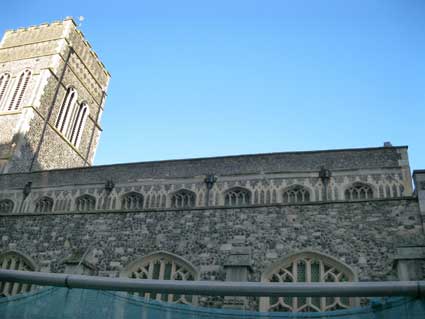 Southern
elevation
Southern
elevation
The nave, transepts and chancel are capped by parapets, the south nave
parapet still retaining the light coloured gault bricks with which it
was restored in the 18th or early 19th century. Of special note are the
hopper-heads above the downpipes which drain the rainwater from the
nave roof. These have little cartouche decorations with initials
(possibly of the churchwardens: 'NA' and
'CS' alternately) and the date
'1741'. Such pieces of 18th
century
metalwork are a rare survival.

And in 2015, following refurbishment...
NA, 1741 ... CS,
1741 ... NA, 1741
... CS, 1741
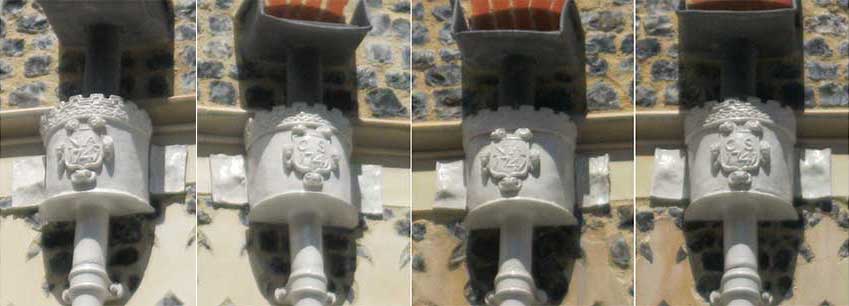
For
other examples of dated hopper-heads, see our Plaques
page (The Walk), Gatacre Road School, Tooley's Almshouses and Arcade Street (dated buildings examples).
 Northern elevation
Northern elevation
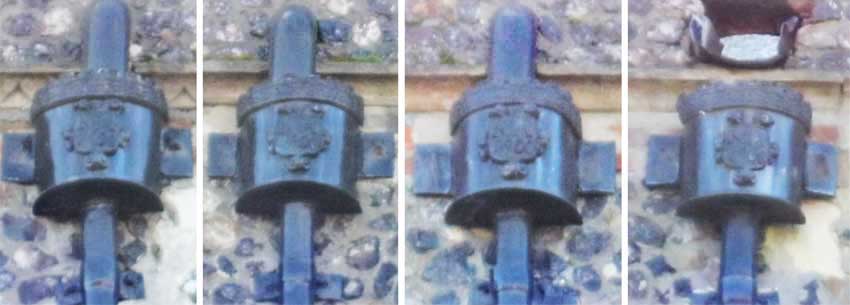
It looks as though one of the hopper-heads on the northern side
reads: 'NA', '1900'.
Archaeology
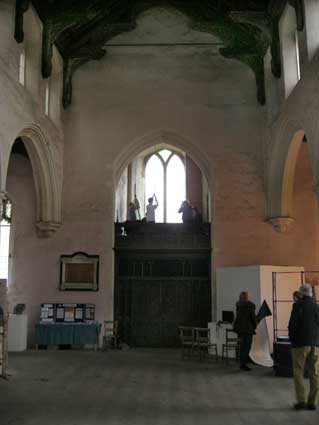
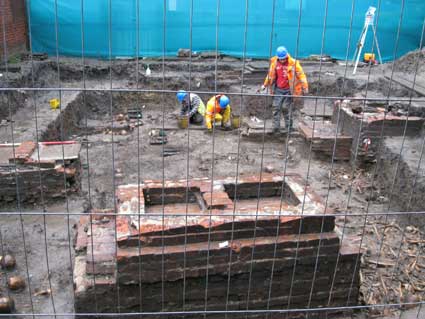
[UPDATE 14.2.2014: St
Mary-at-the-Quay Church in the pouring rain. Prior to its conversion
into a ‘Wellbeing Heritage Centre’ by Suffolk MIND and partners an
archaeological dig is underway, due to finish in April 2014. The open
day coincided with a full peal of the church’s bells lasting over two
hours. The ringers were probably the only warm people in the church,
but there was plenty to see in the extraordinary exposed burials,
accessed through the small priest’s doorway at the side of the chancel,
a table of finds and a child’s skeleton laid out on Henry Tooley’s
tomb. Des Pawson’s (see Links) rope-making
display drew attention to the maritime nature of the church – the clue
is in the title – which originally stood close to the early dockside.
It was built on the site of a previous church over the hundred years
from 1443. As their work progresses, who knows what the archaeologists
will find further down at Anglo-Saxon or even earlier layers?]
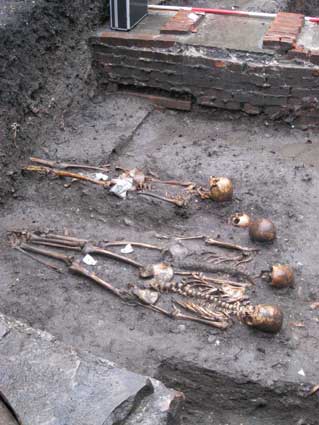
 2014 images
2014 images
Intact, fully-articulated skeletons have been exposed, including the
surprisingly tall individual shown above. However, previous burials in
the very small remaining graveyard have been disturbed in sinking new
graves and brick-built tombs, so the jumbled remnants were thrown into
a charnel pit (below): a rather disturbing mass of the remnants of
humanity. On a board on the tomb of the noted merchant and benefactor
to the town, Henry Tooley, are laid out
the almost complete bones of a child exhumed during the dig.
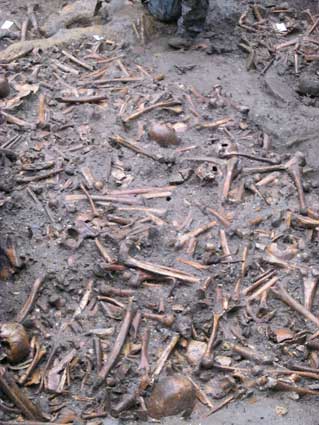

Below, the finds table with a colourful diplay of ceramic shards from a
variety of eras. Of note is the grey jar lip seen at lower right which
is Ipswich ware. 'Ipswich ware' (Middle Saxon, 700-850 AD) is the name
given to plain sandy greyware which was made in two main fabrics -
smooth and gritty. Vessels were generally small, medium and large jars
with plain upright rims. Hanging vessels with upright pierced lugs were
also made, and there were some rarer forms such as decorated bottles.
Jar bases are characteristically very thick, and upper bodies are often
'girth-grooved' by finger-rilling. The ware is thought to have been
made on a hand-turned 'slow-wheel', as opposed to the fast kick-wheel
used by Roman and Late Saxon potters. Used locally, the pots were also
traded and remains have been found over quite a wide area of the
country.
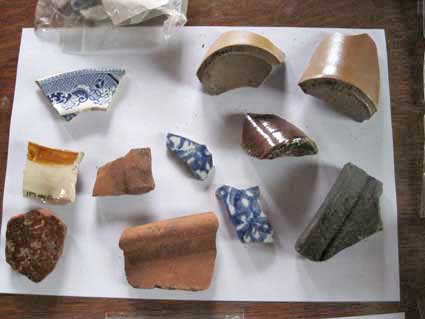
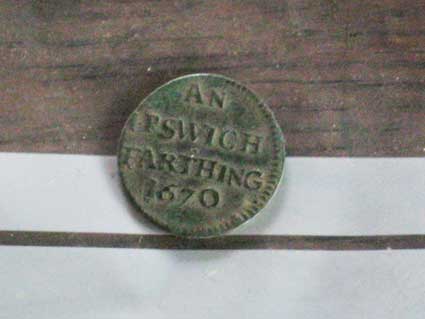
And, for our historic lettering website, it was good to see several
coins found during the first stages of the dig including this
strikingly-lettered example with a fine use of the indefinite article:
'AN
IPSWICH
FARTHING
1670'
Restoration 2014
 2014
images
2014
images
27.3.2014. These photographs
from Star Lane and (below) from College Street/Key
Street from the 27 March 2014 show the huge scaffolding structure under
construction which cover, but does not rest upon the delicate
roof. Within a few weeks the whole was covered in sheeting.

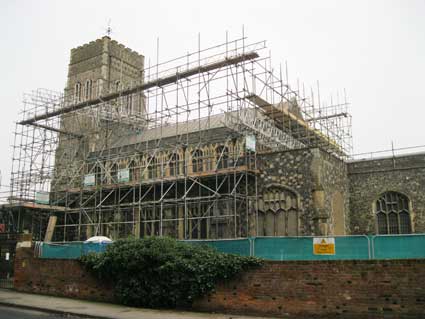
23.5.2014. Here's a fascinating
panorama – probably an unrepeatable view – of Star
Lane, Key Street, the bus depot, the Premier Inn and other Wet
Dock developments
(some completed, some static) and the clock tower of the Custom House
just
visible behind the blue 'Regatta Quay' hoarding. The view is from the
scaffolding surrounding the east wall of St Mary-at-the-Quay during
restoration – the upper platform to the right of the photograph (above
right) – with the camera poked through a slit in the plastic
sheeting: montage of two shots. The only way of getting a better view
would have been to stand atop the St Mary church tower.
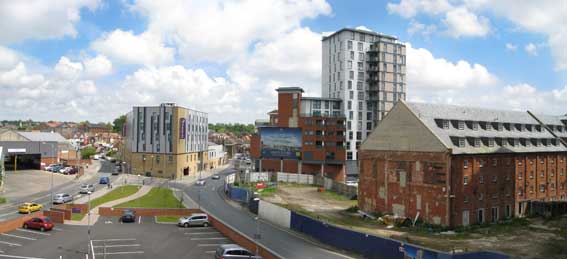 May
2014 images
May
2014 images
Meanwhile, inside the church, next to the altar table, a mass of clear
plastic sacks was noticed. They were full of people.
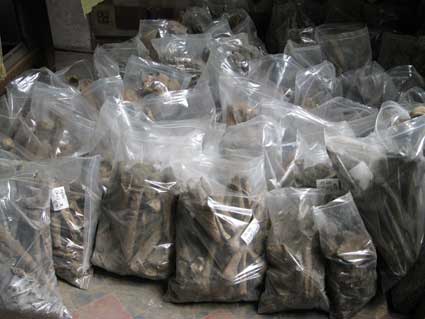
Eye sockets of skulls peer eerily over the tops of the sacks.
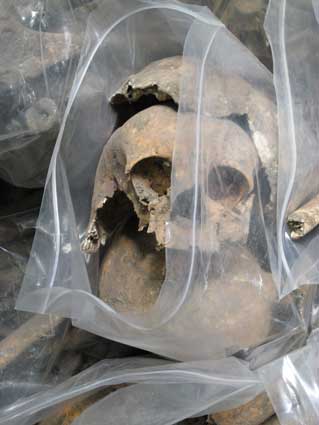
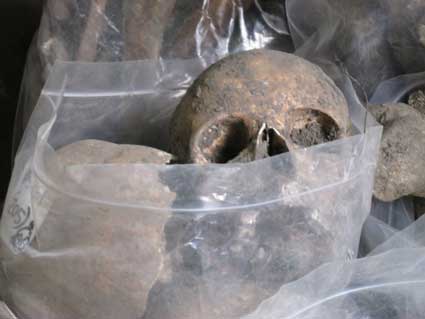
Through the tiny priest's door, and we see an updated view of
the archeological dig on the site to be occupied by the new building.
Although there had been heavy rain in early 2014, it became clear that
the charnel pit was flooded due to ground water coming up into the
trenches. Such are the problems faced by those exploring our history in
the soil and proof that St Mary-at-the-Quay was definitely built on
marshy land: the source of many of its structural problems. All
the surrounding springs seem to converge here.
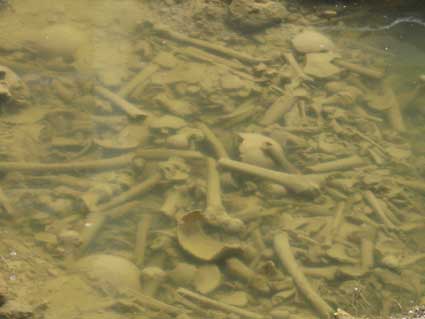
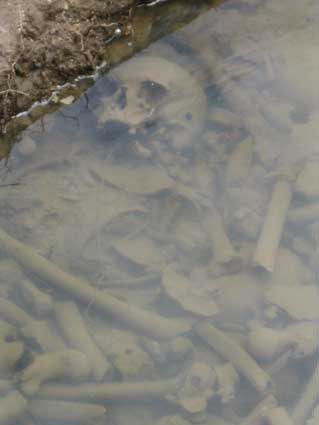
Raching the parts never reached before
Climbing the scaffolding (with permission and safety gear) we viewed
the methods used to examine and repair main roof timbers. That shown
below is being supported by strapping attached to the outer skeleton of
scaffolding. The lower part is currently sitting on fresh air until
sections can be replaced; the adze marks on the upper face of the beam
show the hand-worked finish. The surrounding close-boarding probably
dates to the last, partial refurbishment of the roof in the 1960s. The
flint flushwork integrated into two elaborately-cut stone elements
(note the mason's pencilled 'FACE' lettering indicating the smooth,
dressed outer surface). These are topped off by a greased steel
tie-bar, awaiting its bolt, which runs right across the width of the
church roof to stabilise the structure.
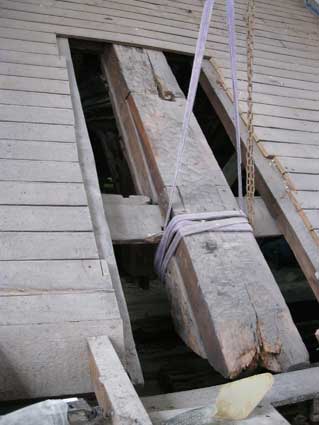
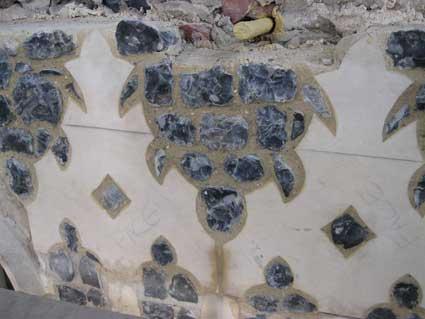
Below: two carved spandrels, in rather good condition, lay on the
scaffolding platform, high up in the roof space.
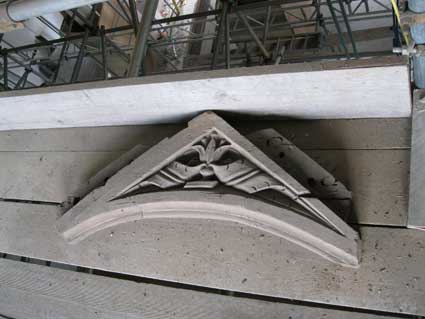
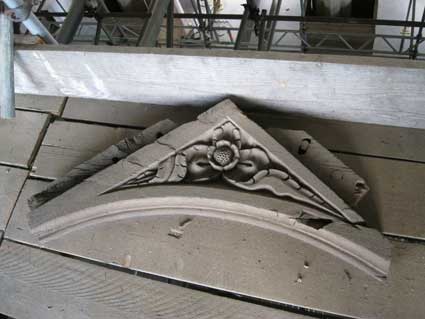
Carved wooden saints, their faces chopped off by Reformation
puritan zealots, on the uprights of the hammer-beam supports. See
our Church of St Clement page for
information about the 17th century activities of William Dowsing in
destroying 'idolatrous' images and carvings.
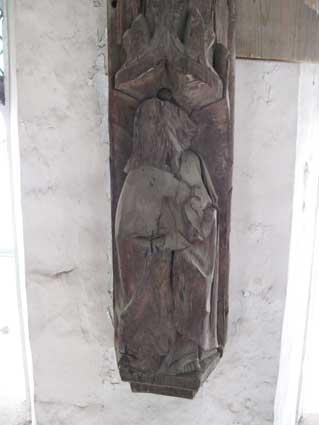
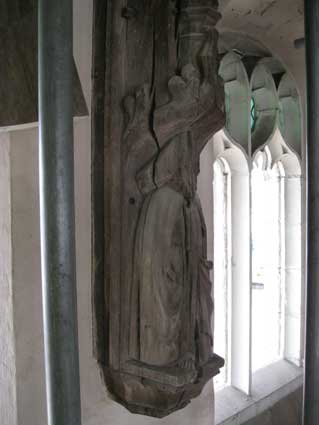
Below: the view from the chancel of the scaffolding structure
within the nave and, right, the view across an upper level showing the
position of the carved saints between the clerestory windows.

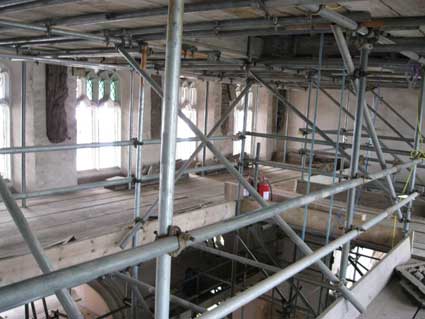
Below: details of spandrel brackets showing, to the left, the
arrangement of the double hammer beam support for the roof. The
exposed tenons indicate the places where the missing carved angels were
located.

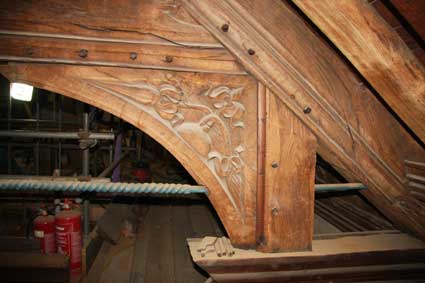 Photographs
courtesy John Norman
Photographs
courtesy John Norman
A selection of smaller images of St Mary-at-the-Quay during
restoration, May 2014.
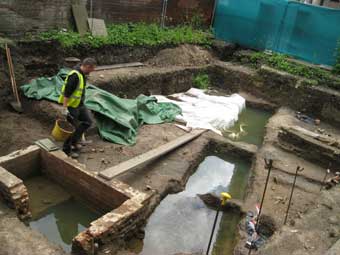
|

|
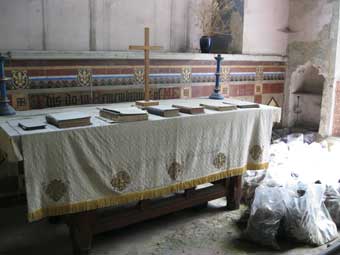
|
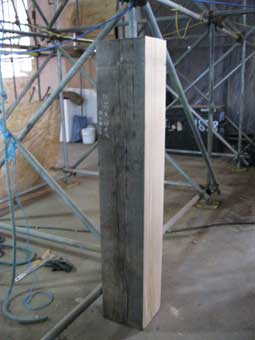
|
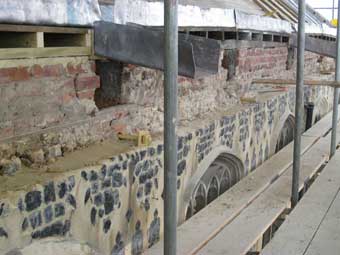
|
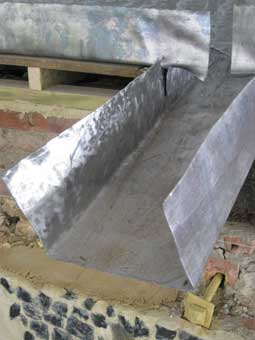
|
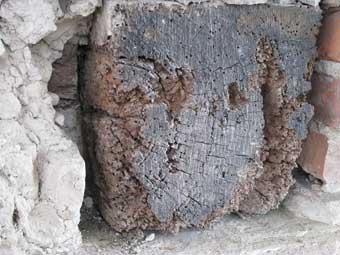
An ancient oak beam displays insect damage.
|
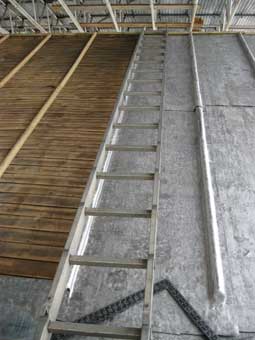
|
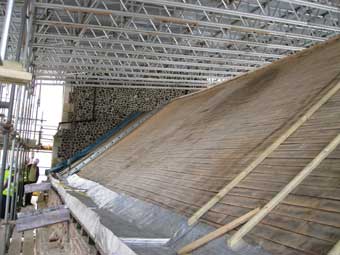
Half-round rods with sand-cast lead sheeting laying on
boards.
|
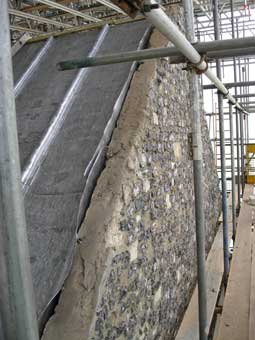
|
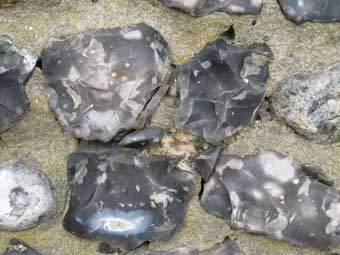
Knapped flints and mortar in situ.
|
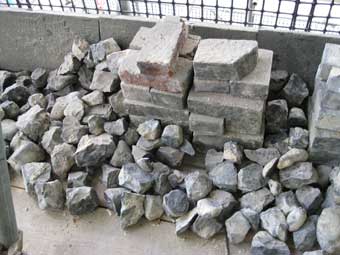
Flints and masonry: work in progress.
|
Nearing completion 2016
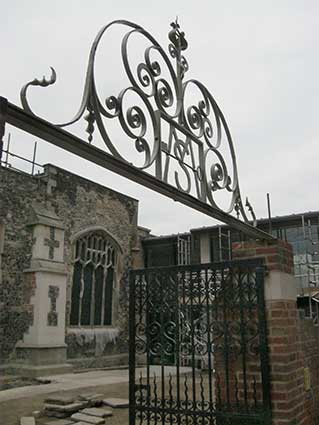
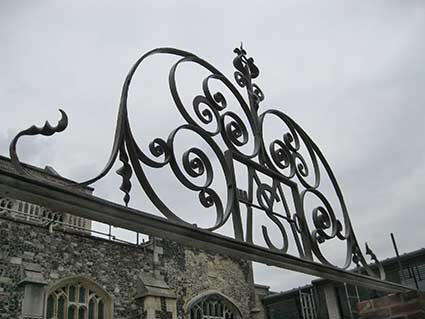 2016 images
2016 images
Above: the return of the wrought iron 'S', 'M' and key motif above the
resored gates with the new wing in the background.
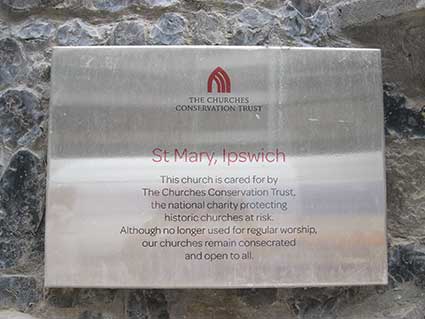
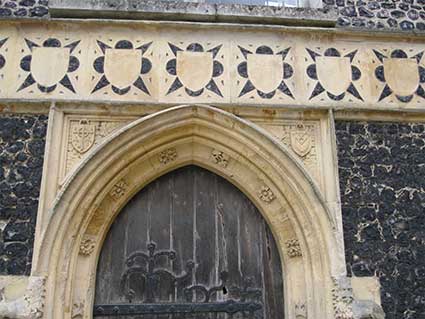
A newly-placed plaque near to the south door in stainless steel (the
old circular plaque shown at the top of this page is still in place)
interestingly names the church 'St Mary, Ipswich'. Give that there are
three other Marion churches in Ipswich (St Mary-at-Elms, St
Mary-Le-Tower, St Mary Stoke), This church really ought be given its
correct name: 'St Mary-at-the Key' by The Churches Conservation Trust.
Also, above right, the restored and cleaned west door, the spandrel
shields are particularly striking.
Grand Opening, October 2016
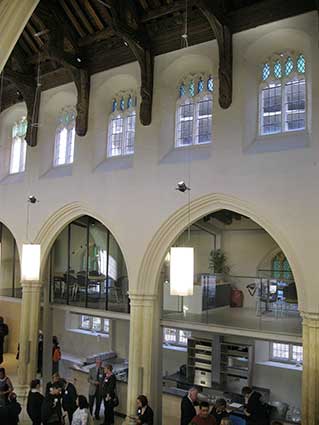
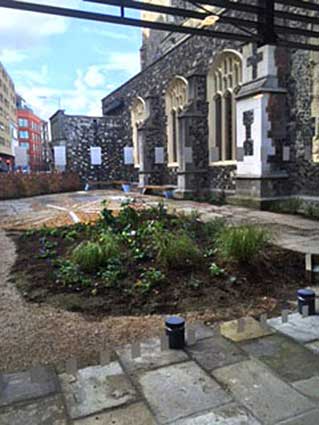 2016 images
2016 images
Below: one of the finest double hammerbeam church roofs in Suffolk
(possibly second only to the church at Needham
Market),
post-restoration.
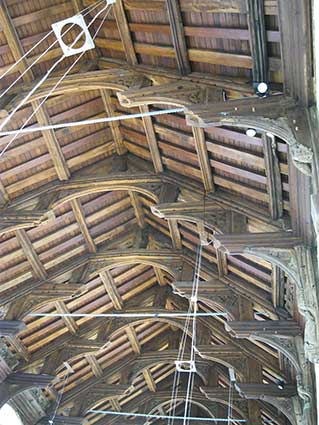

The simple table altar partially obscures the ceramic tile lettering on
the decorative east wall. Below (the second panel damaged):
'I am the
Lilly of the
Valleys'
'I am the
Rose of
Sharon'
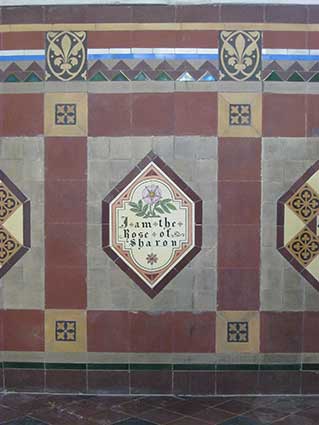
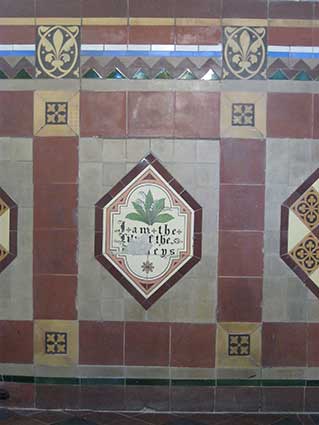
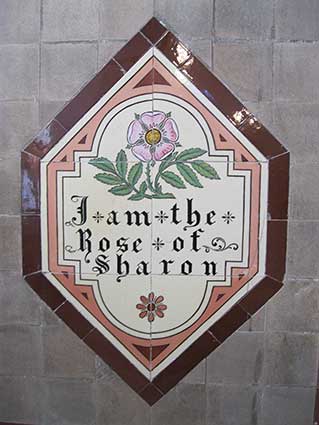
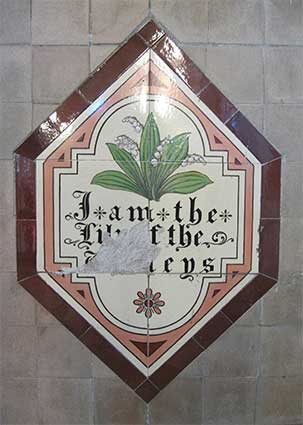 2017 images
2017 images
Centrally, in black and red gothic lettering on a gold background:
'This do in Remembrance of ME'
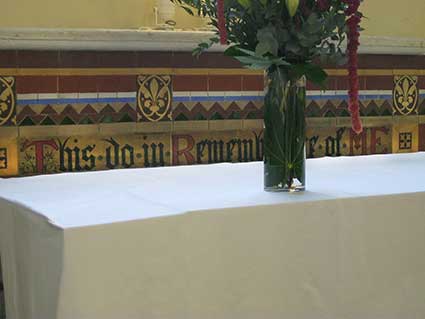 2016
2016
 2017 images
2017 images
The close-ups reveal that this lettering is painted onto a boards,
which are fixed to the wall.

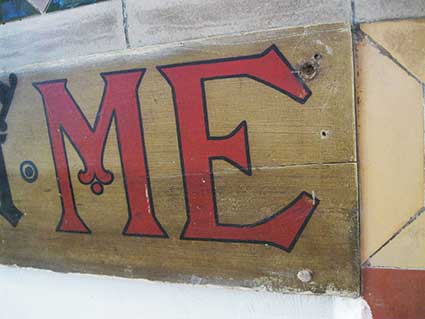
The churchyard dig unearthed these metal coffin plates, the lettering
engraved on them still remarkably readable:
'CHARLES JOBSON
DIED
23rd Augst.
1832,
aged 59 years'
'ANN JOBSON
DIED
30
th Aug
st.
30th Augst.'
Researchers on the restoration
project have found some fascinating information about Mr Jobson and his
life:-
Charles Jobson was born c.1773 in
Ipswich. We know from a record of Freemen of Ipswich that his father
was William Jobson. Charles married Ann Ramsey at St Mary-at-the-Quay
Church on 29 May 1796; both signed their names with an ‘X’. Charles’
father was buried at St Mary-at-the-Quay on 8 March 1809 (the document
is held at Suffolk Record Office).
- Charles had a son, also named
Charles, who married Mary wade from St Mary-at-Stoke parish in 1821.
Charles junior, a Mariner like his father and two generations of male
ancestors before him, also became a Freeman in 1819.
- His daughter, Mary Ann married
James Trott in 1823 who was Master of the brig Union at Woodbridge.
- His daughter, Caroline,
married John Bush in 1828.
- His daughter, Charlotte,
married John Randall in 1829.
On 30 August 1831 Charles’ wife Ann
died at the age of 56 and was buried at St Mary-at-the-Quay. On 12 June
1832 Charles married Jemima Hamblin, a widow of the parish of St Peter.
Jemima carried on Charles’ business at the Smack Inn after his death.
Charles died on 28 August 1832, aged 59 (just two-and-a-half months
since his remarriage), and was buried in the tomb where he was found in
2014 in the graveyard of St Mary-at-the-Quay.
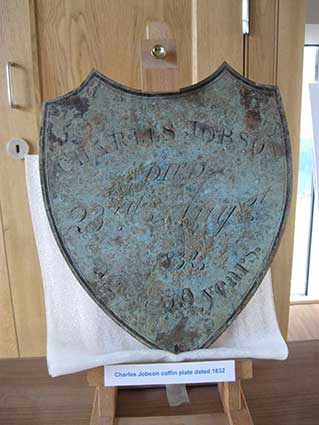
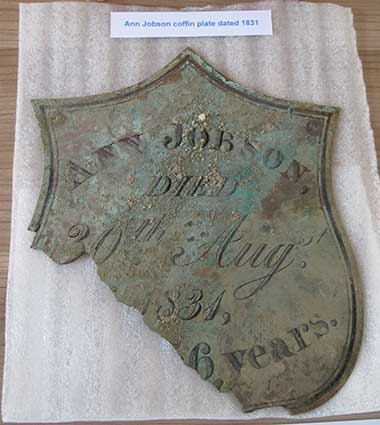
Old bottles dating from 1872 to 1956 found in tomb backfill in the
churchyard excavations. For information about Talbot's mineral waters
which were sold in some of the examples shown here , see our page about
The Unicorn.
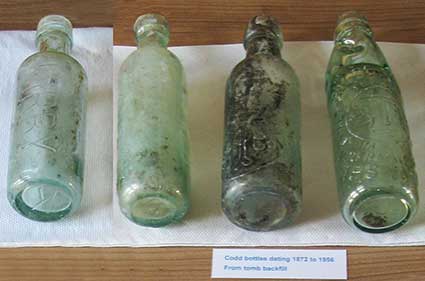
The font has been relocated to a space next to the north door (which is
used as the main entrance), protected by a glass screen.
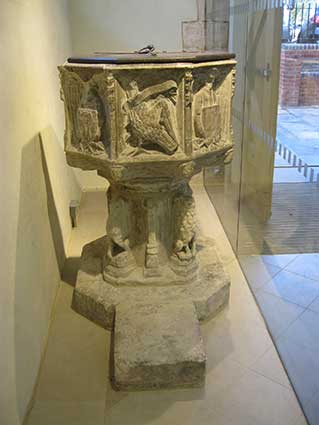
By early 2018 the gold lettering is in place on the curving wall by the
south door...
'QUAY PLACE'
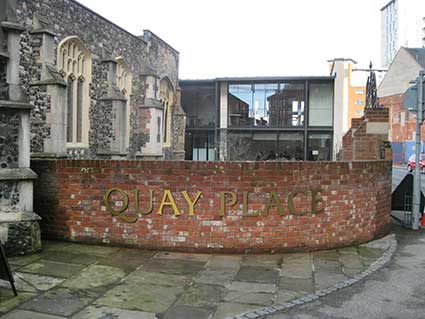 2018 images
2018 images
... matching the gold monogram in wrought iron with the church tower in
the background.
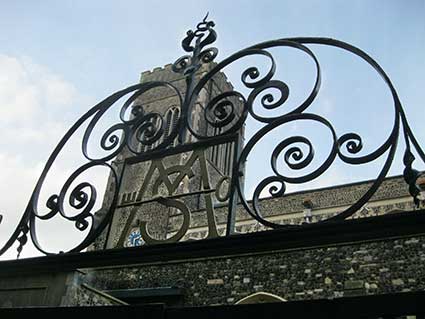
And the view of old and new from the east.
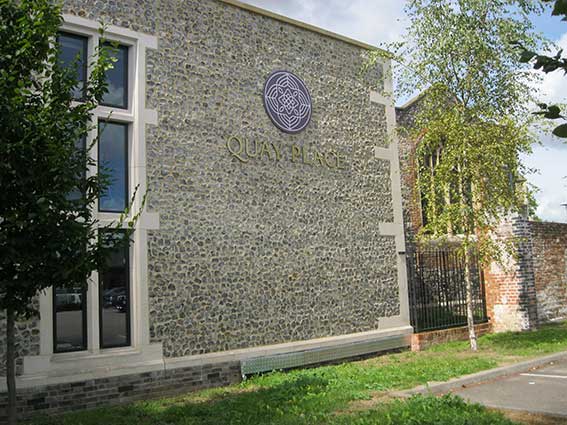 2018 image
2018 image
See our page on The Mill for some 2008
views of Cranfields Flour Mills and the Winerack from inside St
Mary-at-the-Quay.
Home
Please email any comments and contributions by clicking here.
Search Ipswich
Historic Lettering
©2004 Copyright
throughout the Ipswich
Historic Lettering site: Borin Van Loon
No reproduction of text or images without express written permission




 2014 image
2014 image 2013 images
2013 images

 Southern
elevation
Southern
elevation

 Northern elevation
Northern elevation



 2014 images
2014 images



 2014
images
2014
images

 May
2014 images
May
2014 images













 Photographs
courtesy John Norman
Photographs
courtesy John Norman












 2016 images
2016 images


 2016 images
2016 images




 2017 images
2017 images 2016
2016 2017 images
2017 images





 2018 images
2018 images
 2018 image
2018 image